Sheet pans are almost essential in every kitchen. They are great for making a variety of recipes, both sweet and savory, and they come in different sizes. Let’s see what are those sizes and how to choose the one that is the most suitable for your needs.
This article will cover
- Sheet Pan Sizes
- Different Ways to Use Sheet Pan
- How to Choose a Good Sheet Pan?
- What Can You Use Instead of a Sheet Pan?
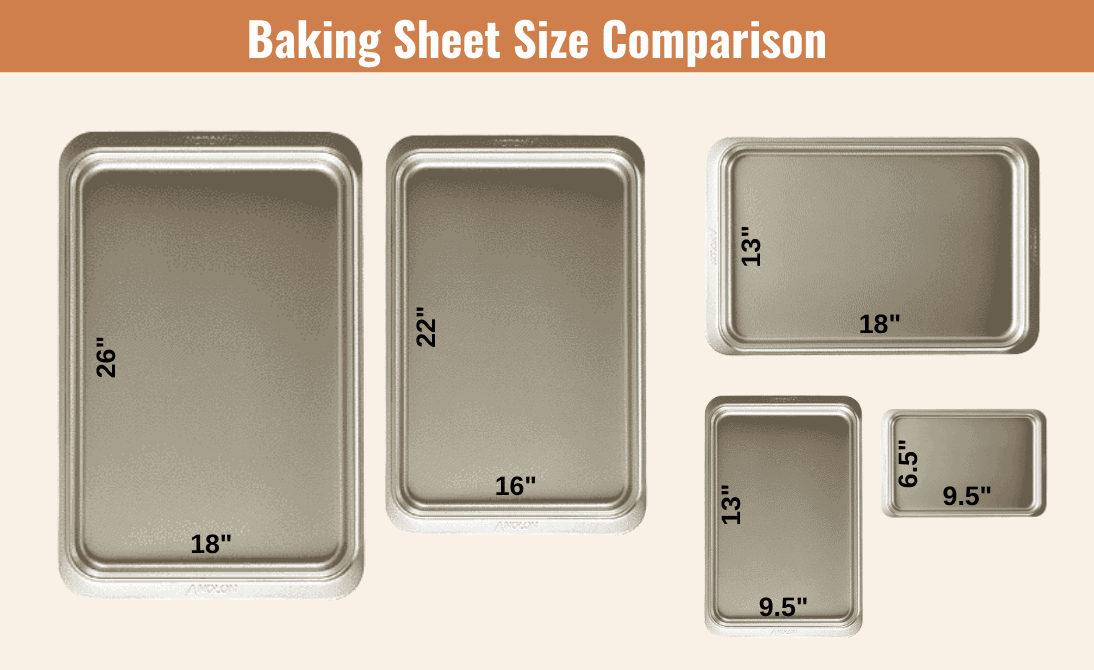
Sheet Pan Sizes
Pan Type | Dimensions | Oven Fit |
Full-Size Sheet Pan | 18" X 26" | 1 pan per shelf |
⅔ Sheet Pan | 16" X 22" | 1 per residential oven shelf |
½ Sheet Pan | 13" X 18" | 2 pans per shelf |
¼ Sheet Pan | 9.5" X 13" | 4 pans per shelf |
⅛ Sheet Pan | 6.5" X 9.5" | 8 pans per shelf |
Full-Size Sheet Pan
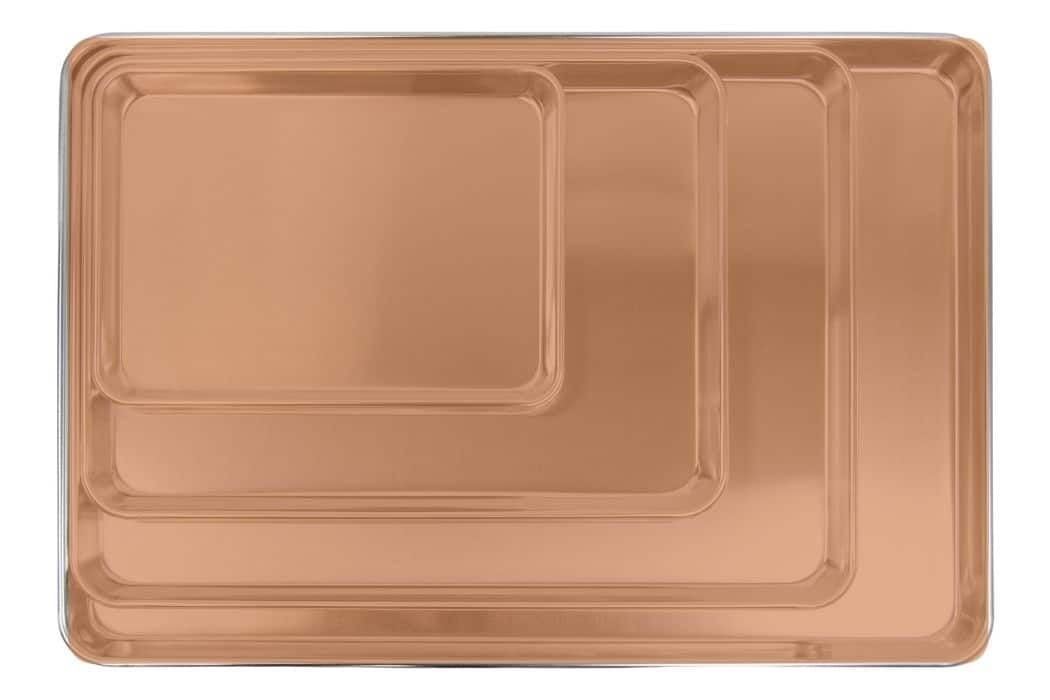
Full-sized sheet pans measure 18 by 26 inches and is usually around an inch deep. If you need a sheet pan for your home kitchen, this dimension would probably not be the best option for you.
This sheet pan may not fit in most of the home ovens. They are most commonly used in restaurants, bakeries, and catering as they are perfect for the high-volume production of cookies, pastries, and similar baked goods.
⅔ Sheet Pan
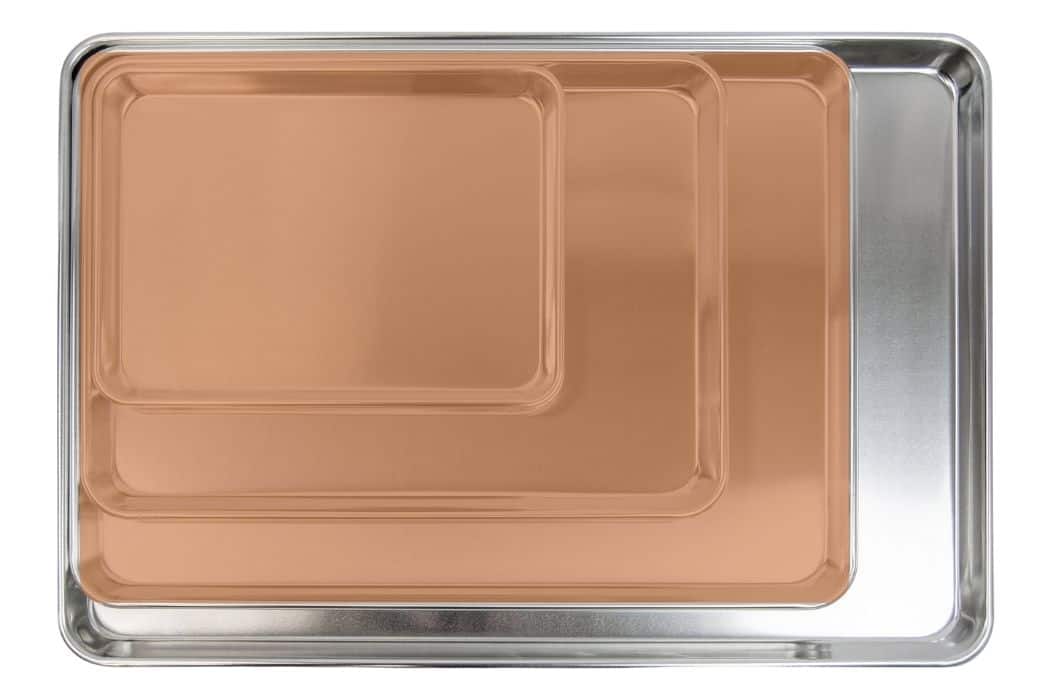
With the dimension of 16 by 22 inches, this size of sheet pan is the largest size that can fit in a standard kitchen oven. If you make a big amount of food at once, this size is a great choice. If you have a small bakery or small home-owned cooking business, several ⅔ sheet pans should be quite enough for the production.
½ Sheet Pan
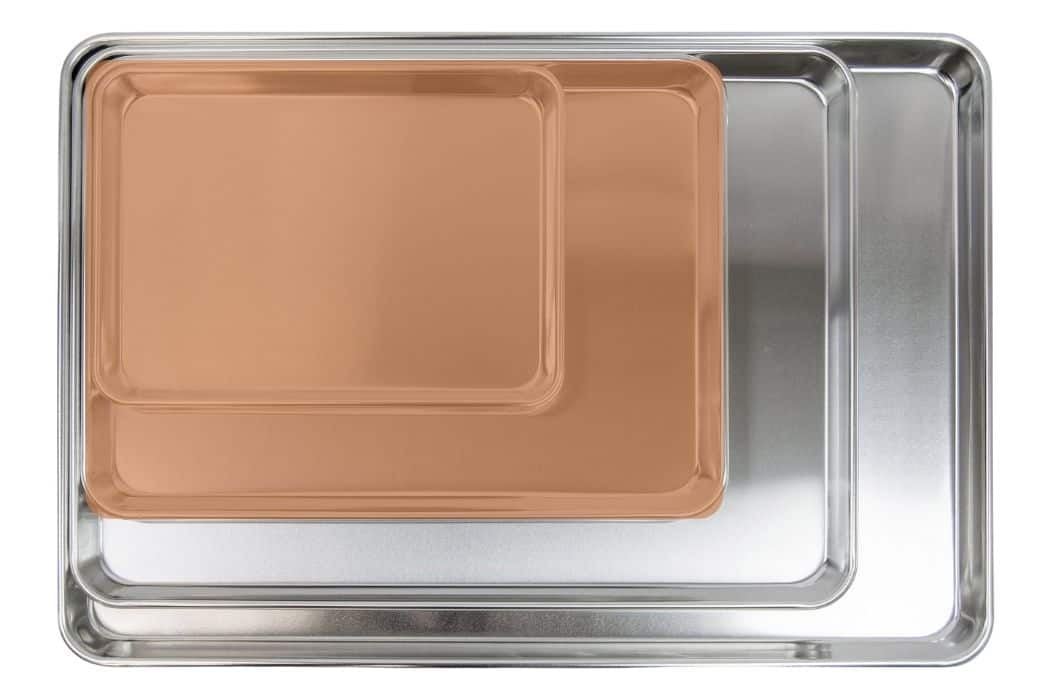
This sheet pan measures 13 by 18 inches. Its width is half of the full-sized sheet pan, while the length is the same. It is perfect for home use. You can roast meat and vegetables, bake a pizza, or make tons of cookies using it.
It fits well in an oven as well as in a dishwasher. It is also a good choice for restaurants as two of them can fit in a standard-sized commercial oven shelf, allowing for baking different recipes at the same time.
¼ Sheet Pan
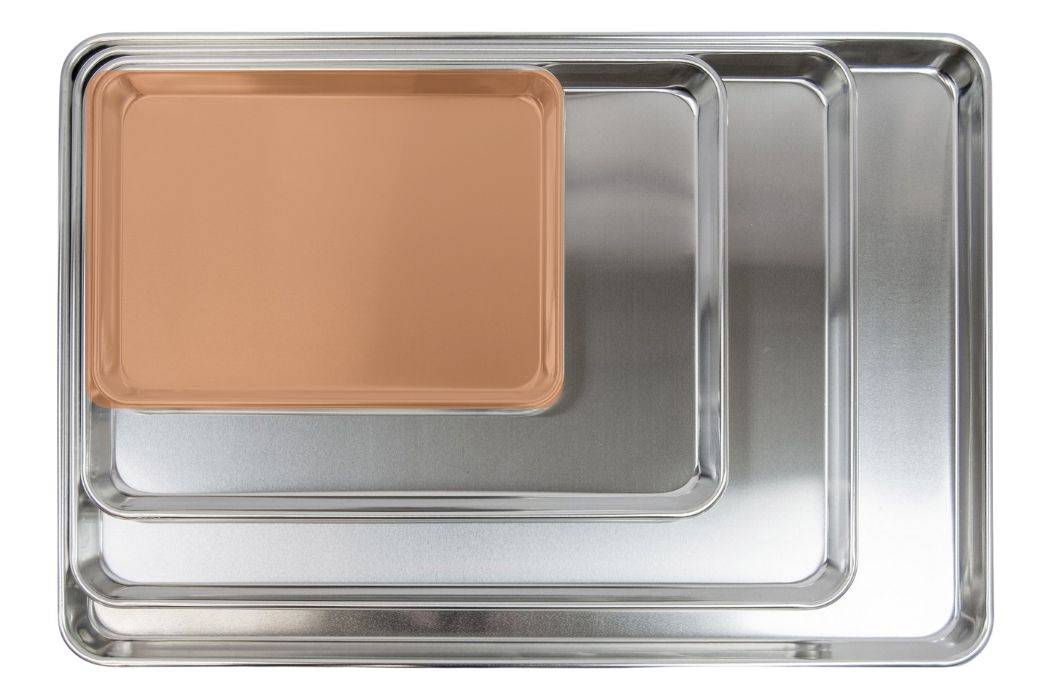
This pan is 13 by 9 ½ inches. They are great for small batches and personal home use. Other than that, restaurants can use them for preparing different meals within one order. You can also use them for meals that you plan on putting in the fridge because they are small so they fit quite well.
⅛ Sheet Pan
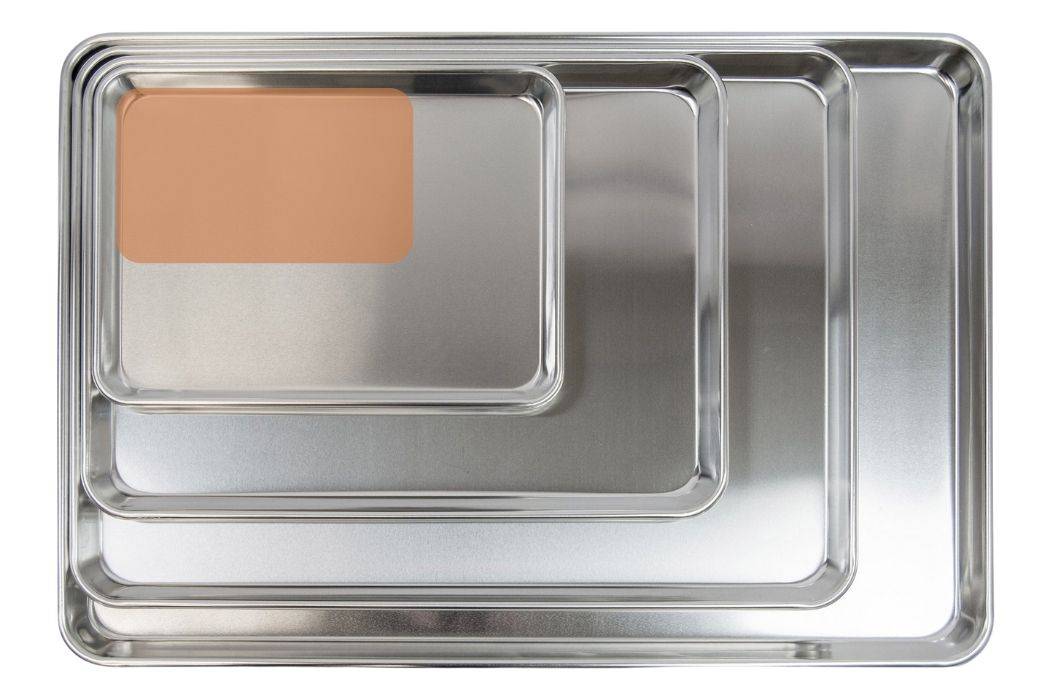
The smallest size of the sheet pan is 6 ½ by 9 ½ inches. It is compact and therefore lighter than the rest. It is good for batches made for one to two persons, it fits well in the fridge and the freezer, and it is suitable for a dishwasher.You can fit eight of them in one oven, so they are also good for making different meals for different family members at the same time.
Different Ways to Use Sheet Pan
There are many delicious recipes that you can make in a sheet pan, that is for sure. While it is usually the main function of a sheet pan, there are other ways that you can make the most out of them.
Let the Dough Rest
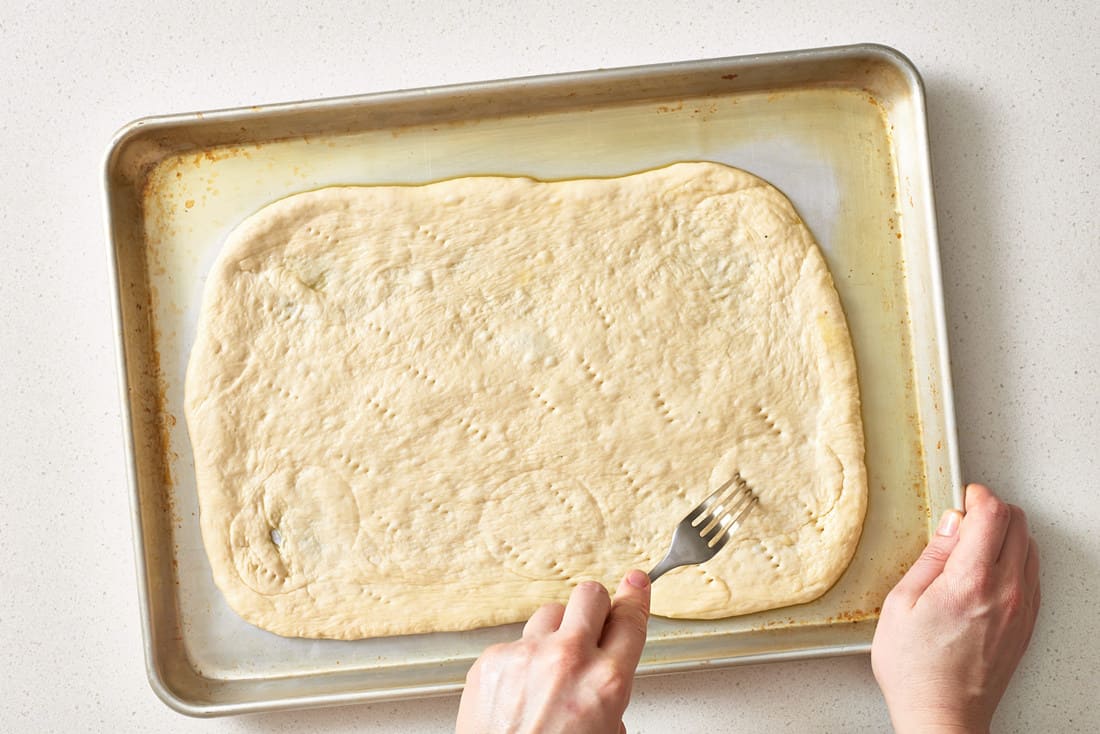
Many restaurants and bakeries use sheet pans as a place where they put the dough to rest. More often than not, a few rounds of letting the dough rest are needed, and full-sized sheet pans are a great tool to use for that.
This is especially useful when it comes to the high-level production of bread and pastries. You can do the same at your home. If you are baking bread, instead of leaving the dough on a work surface, you can use the sheet pan.
Serving Food
If you have unexpected guests and you are making a lot of food, but you don’t have enough trays, sheet pans are a great solution for that too. They are flat, light, and thin, so you can easily hold them and mingle with them if needed.
You can serve cheese, fruits, canapes, and all different kinds of appetizers. If you have a larger size sheet pan, you can also make a full roasted meal and bring it straight to the table.
Preparing Ingredients for a Meal
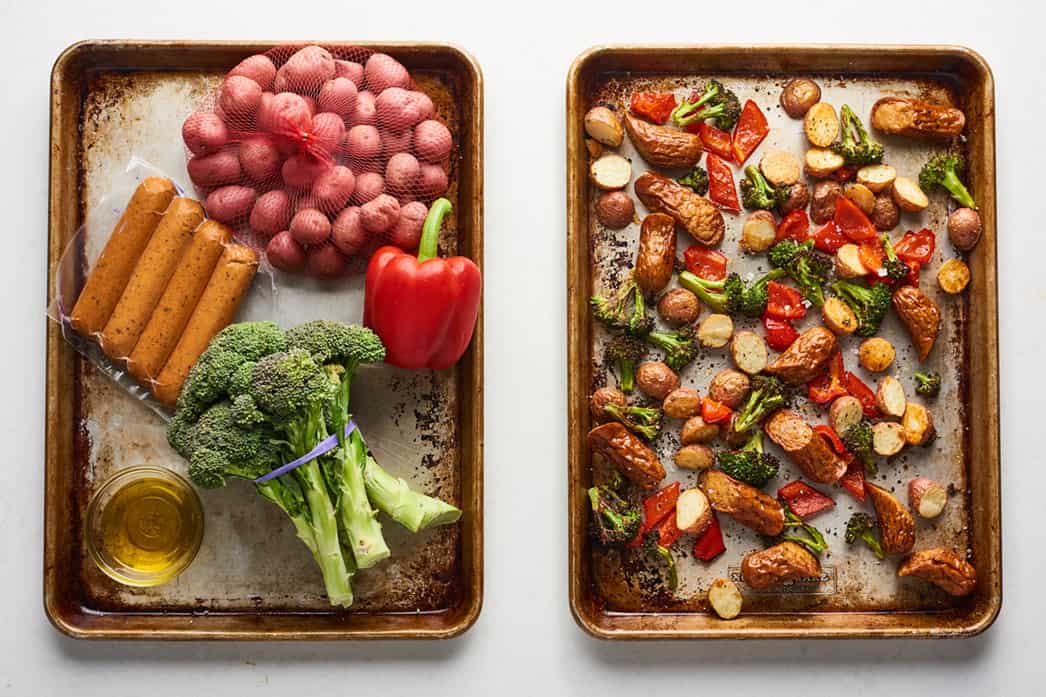
Some people like to prepare the ingredients for a meal as they go. If you are not one of them and you want your ingredients nicely organized and ready to be used, sheet pans are a very nice option. Small bowls and containers are great, but this way you will be able to save some time by washing just one dish instead of many.
Just chop the ingredients that you need and put them in several piles on your sheet pan. If you don’t want them to accidentally get mixed, you can cut aluminum foil or parchment paper and put the piles on them.
That way, you won’t even have to wash the pan later. Also, you can save those pieces of foil or paper and use them for another meal. One more thing this method can be useful for is meal prepping. If you are preparing your meals for a week ahead, just use several sheet pans or one or two that are bigger.
Dish Rack
If you washed a lot of dishes and your dish rack doesn’t have enough space to hold them all, just use the sheet pan. Put a dishcloth on the surface and place the extra dishes on it.
Freezing Food
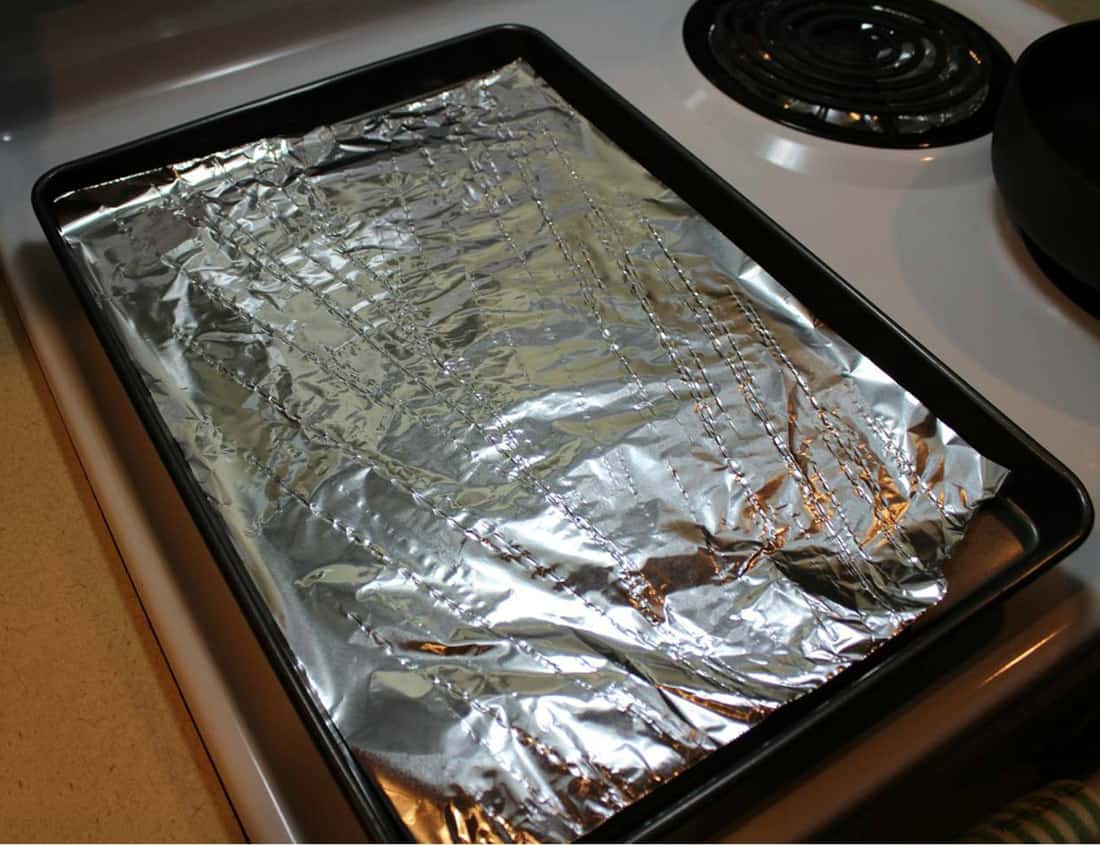
If you made too much of something and you don’t want it to go bad, you can always freeze it for later. If you only have bigger containers that take too much space in your freezer, and you ran out of freezer bags, this is another way you can use your sheet pans, especially if they are on a smaller range.
Just put your food on a sheet pan and cover it with some aluminum foil. Aluminum foil will preserve your food for a longer, and sheet pans are flat and thin, so they don’t take too much space. Problem solved!
Storage Space
If you happen to have a certain combination of condiments or baking powders that you use for a certain recipe that you make often, a sheet pan can save you the trouble of looking for each of them every time.
Just put the combination of them on a single sheet pan and whenever you decide to make the recipe, all of them will be at the same place. It proved to be very handy for recipes that require a lot of condiments, such as curry.
How to Choose a Good Sheet Pan?
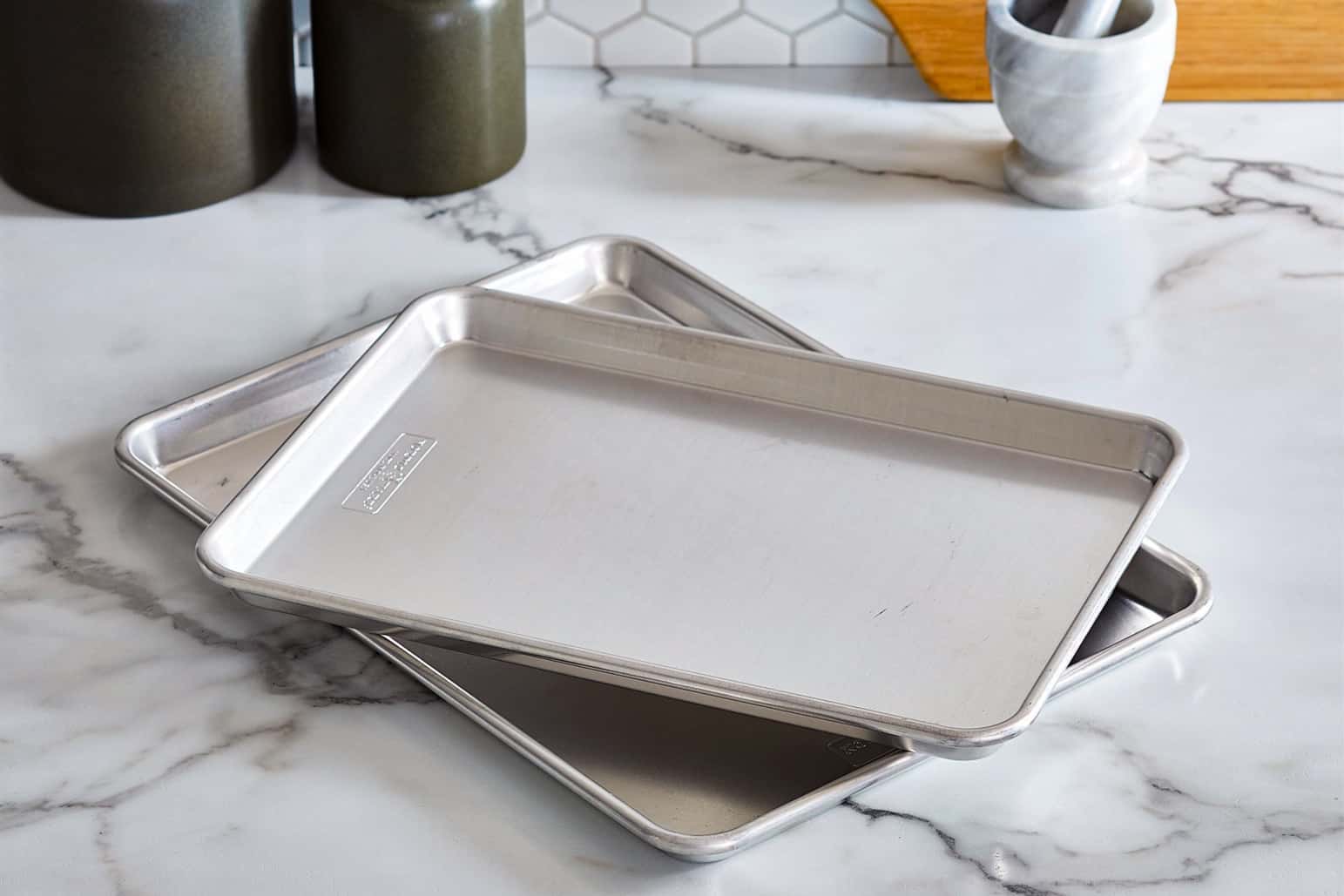
Size
The size that you need largely depends on your needs and cooking habits. If you are not a restaurant owner or a professional baker, you will probably be fine with a half sheet pan.
You can buy several of them if you cook a lot. Smaller sizes are also very handy and useful to have in the kitchen. As explained, there are many ways to use a sheet pan, so the size and the amount you need depend on what you plan on using them for.
Material
Sheet pans are usually made of aluminum, aluminized steel, or covered with a non-stick coat on the surface. They are similar to, but not the same as cookie sheets, which also often have these same materials.
The non-stick option is good if you don’t like using parchment paper for baking. However, if you decide on non-stick, be prepared to change your sheet pans more often. The non-stick coat can start to peel off, and you probably don’t want parts of it in your food.
Aluminum and aluminized steel are also good options. They are more durable and they last longer, and you will have more options for cleaning them.
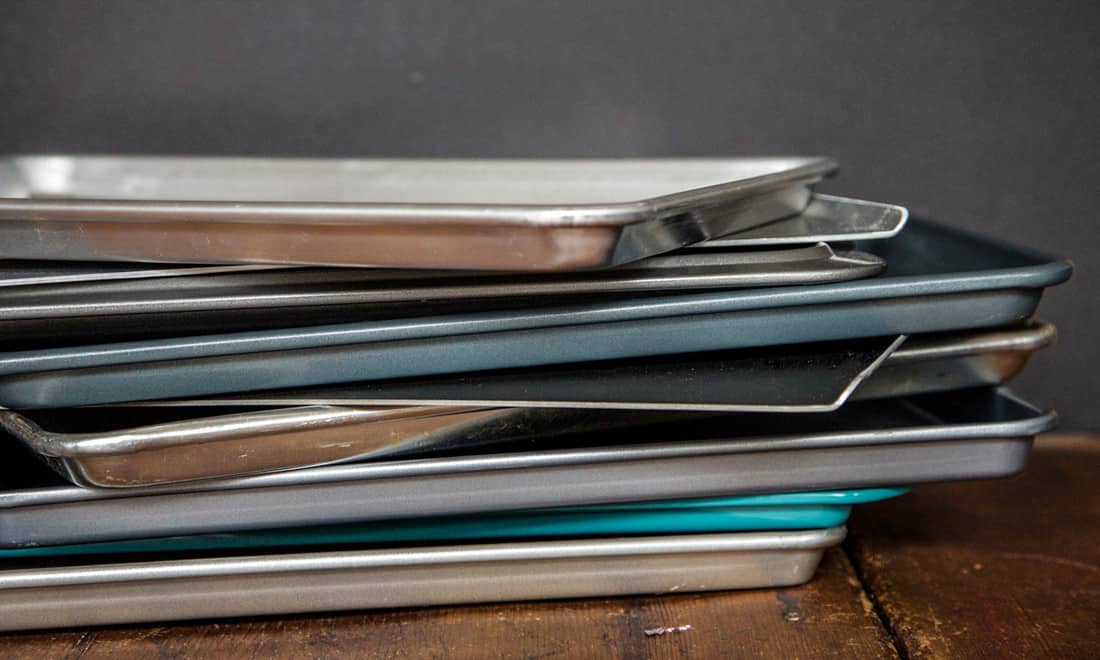
Thickness and Heaviness
These are very important properties of a sheet pan, so keep that in mind when buying one. You may want to choose a thicker, heavier sheet pan, as those are less likely to bend under high temperatures in an oven.
They will also allow for heat to spread more evenly and slowly, so you don’t end up with burned bottoms of your cookies or pizzas. If you aren’t sure of their exact dimensions, you may want to buy them on site instead of online.
What Can You Use Instead of a Sheet Pan?
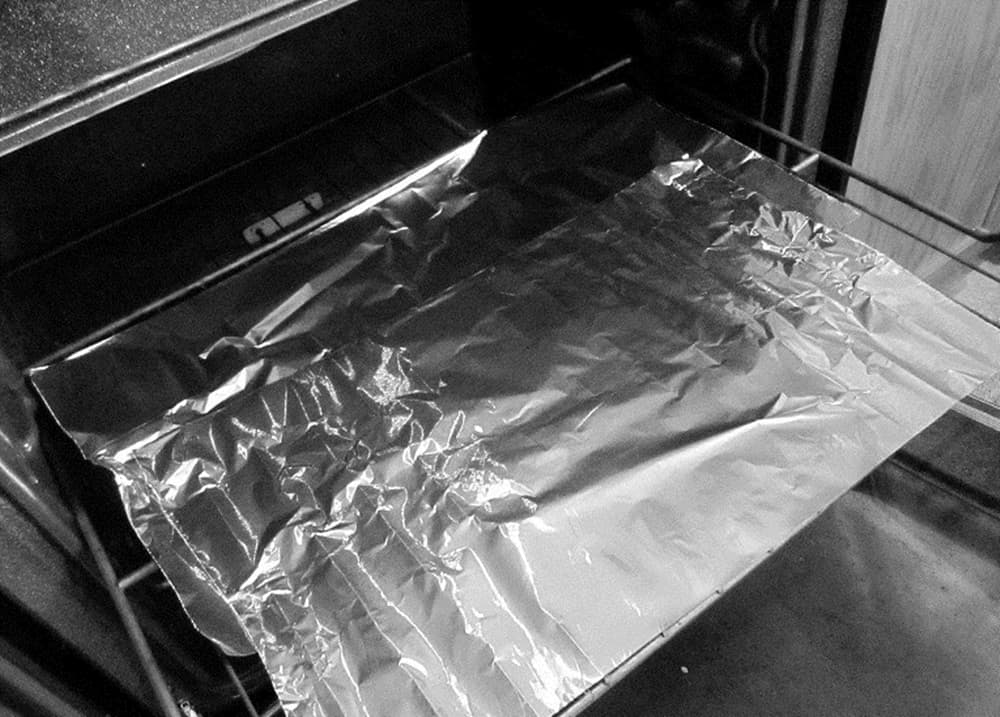
If you still don’t have a sheet pan and you want to bake something, there is a very nice alternative to it. Aluminum foil, like some sheet pans, is made of aluminum, so it can be used as a substitute in certain cases. Keep in mind that it is a lot thinner than the actual sheet pan, so you need to adjust the temperature and baking time according to that.
You may not be able to roast a chicken or anything heavy, but you can certainly bake some cookies like this. Fold the aluminum foil a few times and place the cookies on it. Bake for a shorter time and under lower temperature than you would in a sheet pan, and your cookies will be just as delicious.
Summary
A sheet pan is highly useful cookware and it comes in five different sizes to meet everyone’s needs. Professionals usually opt out for bigger sizes, while the smaller sizes are a great option for a home kitchen. Whatever size you choose, make sure beforehand that it will fit in your oven.
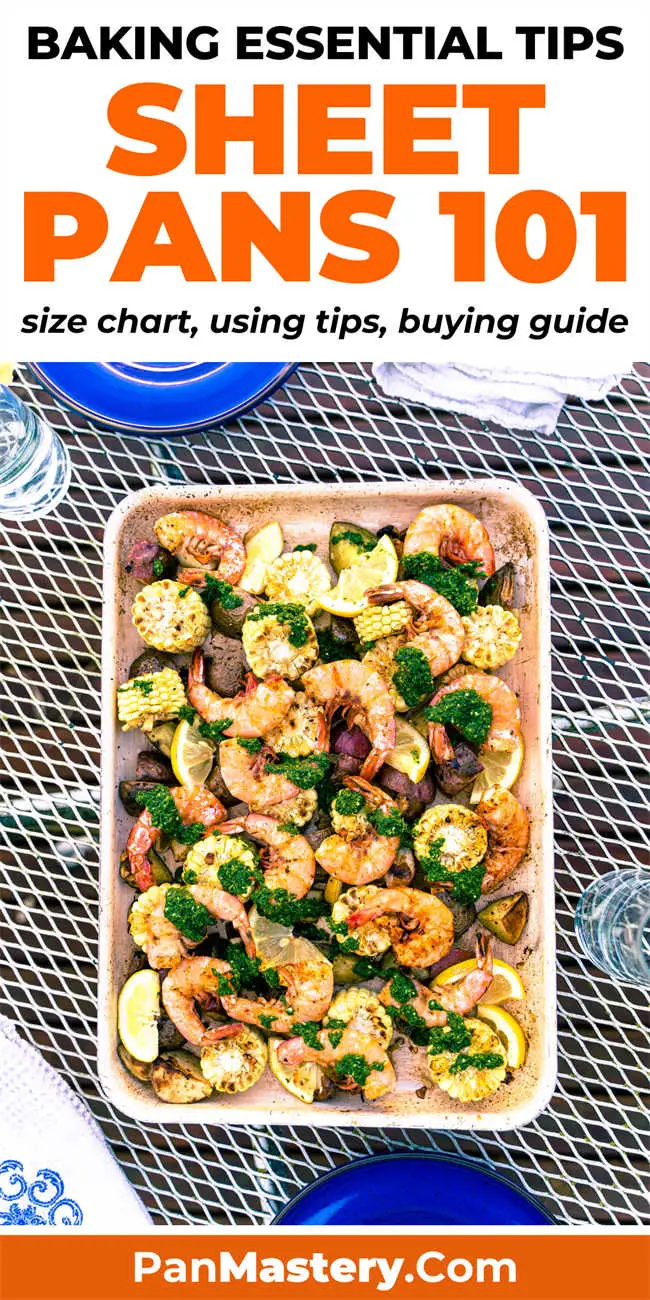

Michael Johnson is the founder of Pan Mastery, Inspired by his blacksmith grandfather’s legacy has a deep appreciation for hand-crafted pots and pans, he provides invaluable guides, reviews, and recipes to enhance your culinary journey.
